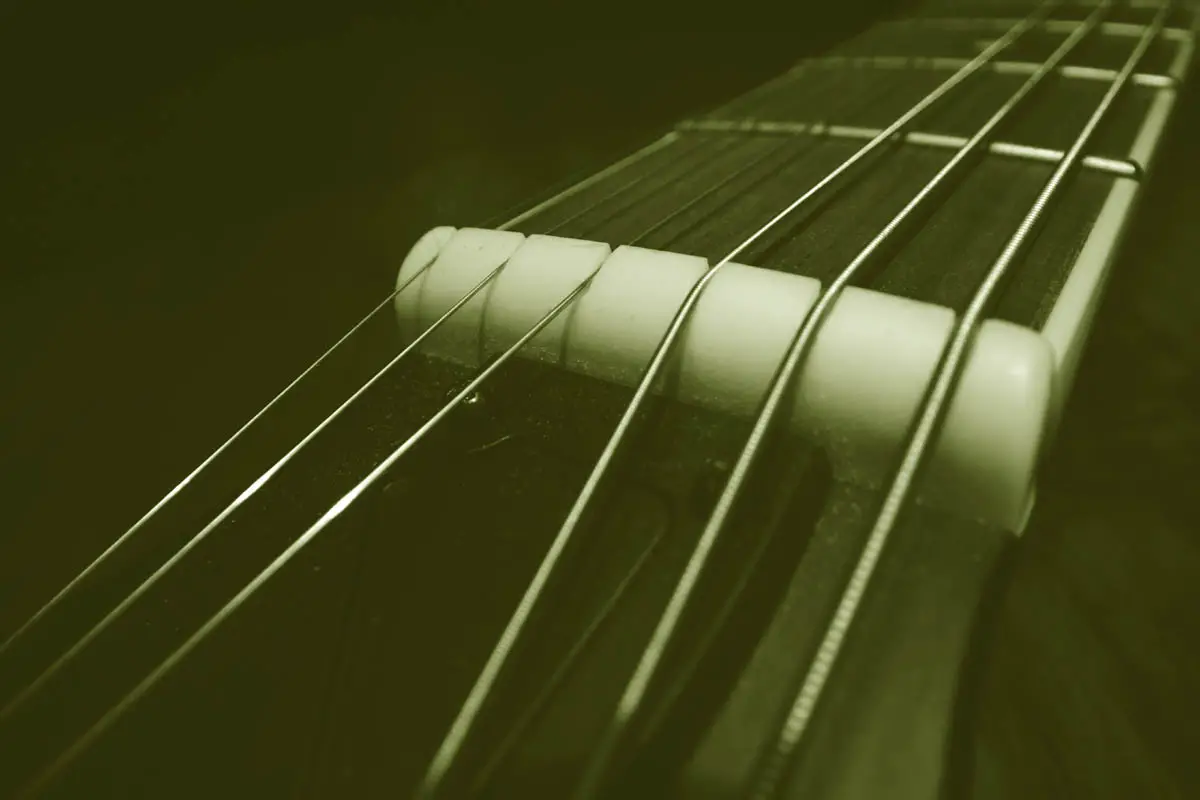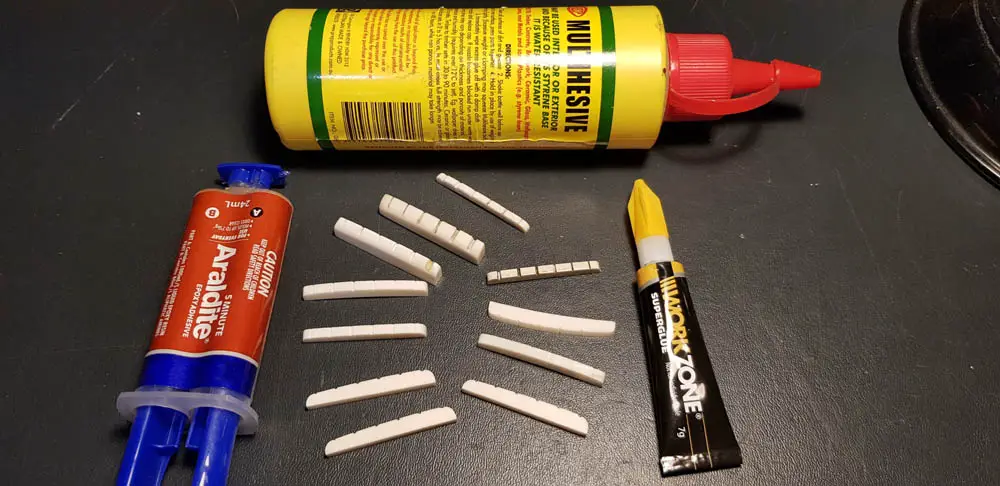Guitar Nut is Loose or Fell Off? (Gorilla Glue the Nut?)
With some guitars the nut will be loose and fall off when you change the strings, as there is no tension to hold it in place.
This is quite normal with guitar nuts that haven’t been glued on, and you can easily fix them on the neck again with a little glue.
The best glue to hold a guitar nut in place with is a couple of drops of superglue, or some simple white woodworking glue or craft glue that you may have used at school. This will prevent your guitar nut falling off when you change all the strings at the same time.
How much glue should you use though? Too much, and removing the nut in the future to replace it could be a difficult job. There are also some glues you should never use to glue a guitar nut.

Should Guitar Nuts be Loose or Fall Off?
It’s quite normal for a nut to fall off your guitar after removing all the strings, and it’s nothing to worry about. Many guitar makers don’t glue the nut on because it’s not strictly necessary.
When the strings are tuned up, the tension easily holds the nut in place, and it’s unlikely the nut will slip.
Some electric guitars have a slot where the nut sits, and this slot may have expanded due to the wood drying further since the guitar was made. The nut may have been snug originally, but now slips out easily.
You might even find that a nut will become loose easily fall out in a dry season and not during periods of higher humidity.
Reasons to Glue A Guitar Nut
You may find it easier to change strings with the nut glued in place, and many people prefer it for this reason.
If the nut is loose on your guitar it may slip sideways when you start bringing the low strings up to tension, and this can add frustration to the job.
Another problem that this can prevent is the nut falling out and getting broken, requiring a new nut to be made and fitted.
If you’re not experienced at setting up a new nut correctly, then you would need to pay a guitar tech to do this for you. That’s a load of money and inconvenience you don’t need.
Rather than being anxious about damaging the nut when you change your strings, you could lightly glue the nut in place for some peace of mind.
Let’s check out some nut glue choices.
Using Superglue for a Guitar Nut
Superglue is very strong and can make a mess of your guitar if you aren’t careful. For this reason many people don’t like using it on guitars.
If you are experienced with using glue, then this can be an option. Ensure the nut is centered properly though, as superglue sets very quickly, and could leave you needing to remove the nut again.
If you are extremely careful with it though, a couple of drops (and I really mean 2 drops!) are plenty to hold a nut in place.
Before doing this, I recommend using masking tape to protect on each side of the slot to prevent accidental spillage.
A very small amount of superglue is plenty strong enough, and the nut can be removed again with a sharp tap on the end of the nut.

Using Titebond for a Guitar Nut
Titebond is a glue made from wood resin and water. It is primarily made for bonding pieces of wood together, and it dries clear and strong.
This glue comes in both liquid and paste form, and I recommend using the liquid type for gluing a guitar nut in place.
Like other glues, you only need 2-3 small drops of this glue, and some people even mix it with a little water to thin it further.
Being a water-based glue, this is a good choice for gluing your guitar nut on, as any spillage can easily be cleaned up with a damp cloth.
Using Elmers Glue for a Guitar Nut
Elmer’s glue is a type of adhesive typically used in crafts or repairs. It is made of an acrylic resin and water, and comes in both white and clear forms.
This makes it an ideal glue for gluing your guitar nut, as you can easily use a small amount, and the bond strength is low enough so you can easily remove the nut at a later stage.
Like Titebond, Elmers is water-based, making for an easy clean up if you accidentally drop some on the neck or fretboard.
Once again, just use 2 or 3 drops – it’s enough!
Don’t Use Gorilla Glue for Guitar Nuts!
Gorilla glue is composed of two different polymers: one with a water-soluble acrylic adhesive and the other with an epoxy resin. The two polymers react when mixed, forming a very strong bond.
This type of glue is NOT recommended for gluing a guitar nut on with, as it will make removing the nut in the future likely to damage your guitar by pulling off some of the wood with it.
Other Glues You Should NOT use for Guitar Nut
- Liquid-poly modeling glue – this melts the surface of plastic slightly and is way tooo strong.
- Silicone – this will make a mess, is hard to get off, and is too rubbery.
- Contact Glue – Too messy and rubbery, hard to remove.
Basically don’t use any soft-setting glue, as this will prevent the nut from contacting the neck properly, and will negatively affect your tone and sustain.
Conclusion
When the nut is loose and falls off your guitar it can be alarming the first time, and you can safely use a few small drops of glue to hold it in place.
Be careful to center the nut properly when gluing it on, as the strings will not be aligned correctly if the nut is off to one side.
Also make sure the nut is hard up against the slot, or you will find your intonation is out, and your guitar may sound out of tune.
Finally, if you put the strings on before the glue sets, make sure the nut doesn’t creep sideways as you tune the strings up, otherwise you’ll find yourself removing the nut again later!



